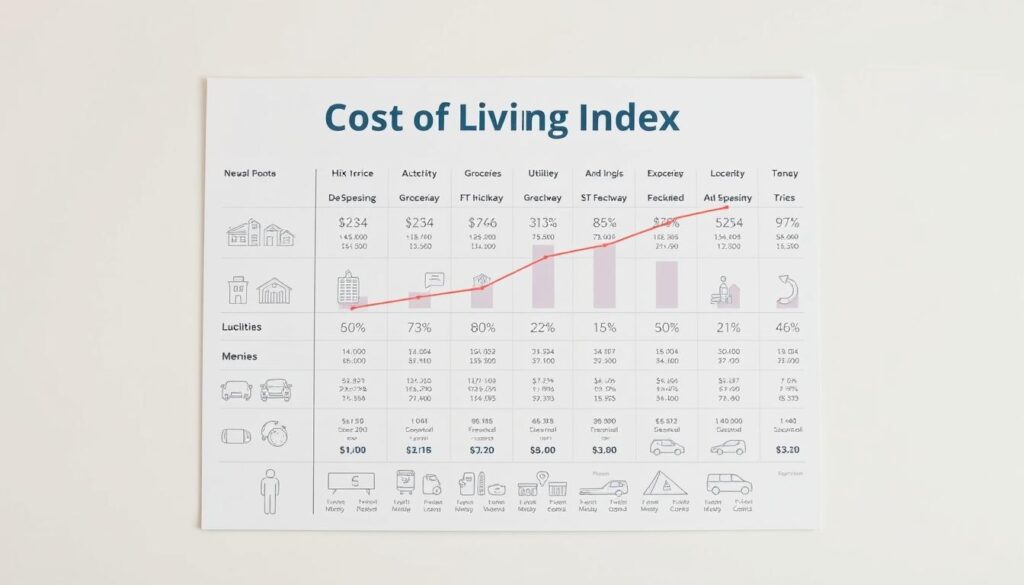Fact: the average Social Security check hovers near $2,000 per month, while the typical U.S. household aged 65+ spends about $4,345 each month.
That gap frames the challenge: total cost matters more than any single bill. I’ll show how city choice, local taxes, and housing markets compress that gap.
I use data from Census, BLS, Zillow, AreaVibes and SSA to build a practical list. Tallahassee, parts of Florida and Texas, plus Southeast cities, often keep total living outlays near the $2,000 target.
My approach: break down average cost by housing, utilities, food and healthcare. I explain how no-income-tax states, competitive rent markets, and public systems improve the score for retirees.
Ask yourself: where can i retire on $2000 a month? Read on to see cities that balance income, services and livability so a person can stretch Social Security and modest supplemental income.
Key Takeaways
- Social Security is the base income: plan around realistic payouts.
- Total cost, not single bills, determines feasibility.
- Choose cities with low housing and friendly tax systems.
- Compare healthcare, transit and livability score before moving.
- Pair benefits with modest supplemental income for stability.
What People Mean by “where can i retire on $2000 a month?”
The core question is simple: will Social Security near $1,976–$2,000 plus modest savings reliably cover rent, food, utilities, healthcare and transportation in a given city? I break this down into line items so you see trade-offs clearly.
Priorities first: housing dominates cost living choices. Healthcare and transportation follow: seniors average about $753 per month for transit and roughly $7,540 per year on health for 65+ households. That math shows why many places exceed available income without planning.
Use these rules when comparing locations: live near services to lower transit cost, lock fixed-rate leases to tame volatility, and combine social security with small predictable income streams. Local taxes and municipal services change how far each dollar stretches across regions and countries.
- Match daily expectations to realistic costs.
- Prioritize clinics and prescription networks for health security.
- Build a margin for utility and grocery price swings.
| Category | Typical U.S. Value | Why it matters |
|---|---|---|
| Housing | Largest share | Determines viability of any per month budget |
| Transportation | ~$753 monthly | Second-largest for many seniors; cut by living near services |
| Healthcare | ~$7,540 annually | Essential: limits choice if access is poor |
How We Chose Affordable U.S. Cities for Retirees on $2,000 per Month
My method blends household surveys and housing indices to produce a defensible city index. I prioritize costs that matter most: rent or mortgage, utilities, groceries and basic insurance. Each item is modeled as an average cost living input so totals reflect typical monthly realities.

Core cost-of-living metrics
I score rent, mortgage, utilities and food using Zillow and BLS outputs. This yields a normalized cost metric for each city and capital region.
Livability, climate, and senior population share
I weigh AreaVibes score, walkability, safety and percent of residents 65+ to ensure services match retiree needs. Climate norms affect heating and cooling cost estimates.
Taxes and healthcare: why policy and access matter
Tax treatment of retirement income, property levies, and Medicaid access change after-tax spending power. I also map hospital density and travel time to primary care.
Data sources used
| Input | Source | Purpose |
|---|---|---|
| Population & demographics | U.S. Census ACS | Calibrate services and retiree share |
| Spending patterns | BLS Consumer Expenditure | Average cost living and cost items |
| Housing indices | Zillow | Rent and mortgage benchmarks |
| Livability & scores | AreaVibes, Sperling’s | Safety, amenities, healthcare access |
Validation: I triangulate with Tax Foundation, FRED and SSA data. Results are time-stamped to July 14, 2025, so the index reflects recent years of change and informs prudent personal finance choices.
Florida Leads for Low Cost Living and No State Income Tax
Florida’s no state income tax and diverse city options make it easier to stretch Social Security and modest income. The state mixes inland capitals and beach towns that offer different trade-offs in cost living, services, and weather.
Tallahassee: sub-$1,300 homeowner costs and strong livability
Tallahassee stands out as a capital with homeowner costs near $1,248 and renter totals around $995 per month.
The city posts a livability score of 85 and costs nearly 10% below average for older residents.
About 11% of the population is retirement-age, so local services and clinics match demand. That mix makes Tallahassee a practical place for many retirees seeking low cost living and civic amenities.
Coastal value: Fort Myers, Jacksonville, Pensacola
Fort Myers pairs beach access with a livability score of 85 and a retiree share near 22%. Homeowners average $1,746; renters about $1,468, and overall costs run ~4% above national.
Jacksonville posts a score of 84, homeowner averages near $1,197 and renters around $1,073, roughly 4% below national cost living.
Pensacola offers one of the best price points: homeowners near $929, renters about $1,136, and total costs about 11% below national.
Other contenders and how to use the index
Orlando, Daytona Beach, Tampa, and Lakeland also appear on lists for competitive rent and livability score profiles. Use the index to compare housing, safety, and amenity access when selecting a place.
| City | Homeowner Avg ($) | Renter Avg ($) | Livability Score | Cost vs National |
|---|---|---|---|---|
| Tallahassee | 1,248 | 995 | 85 | ≈10% below |
| Fort Myers | 1,746 | 1,468 | 85 | ≈4% above |
| Jacksonville | 1,197 | 1,073 | 84 | ≈4% below |
| Pensacola | 929 | 1,136 | 83 | ≈11% below |
- Weather: mild winters add value; summers are hot and humid—factor cooling costs into budgets.
- Tax: no state income tax increases take-home Social Security and other income.
- Use the index: match score, housing, and population mix to your desired lifestyle and total monthly costs.
Texas and the Southwest: Room to Stretch a $2,000 Budget
Texas metros offer scale and value: lower taxes, broad services, and many neighborhoods with submarket bargains. I begin with El Paso because its mix of amenities, low cost living, and tax rules makes monthly budgeting more predictable.
El Paso first
El Paso posts average rent near $976 and mortgage payments around $965. Overall cost living runs roughly 11% below national. One-bedroom units in some neighborhoods drop to about $850, and Texas has no state income, inheritance, or estate tax.
Compare major metros
Dallas, San Antonio, Corpus Christi, and Midland trade bigger services and job bases for faster price growth. These cities offer choices in rent and housing, but growth can push costs higher.
Budget watch-out
Lock in housing: fixed-rate mortgages or long leases reduce exposure to rising rents. Track weather-driven utility use—desert heat raises cooling bills—and monitor population trends that pressure rent.
“Buy where neighborhood averages still leave room for savings; test your local budget before moving.”
- Hunt value pockets within metros to access healthcare and shops.
- Match after-tax income to local services and transportation needs.
- Use average metrics and the five market metrics to shortlist two or three cities before committing.
Southeastern Standouts Beyond Florida
Several Southern cities balance expanding healthcare networks with moderate housing, which helps keep monthly budgets steady.

Raleigh, Greenville, and Columbia present a target balance: growing services, stronger hospitals, and reasonable average cost living compared with larger coastal metros.
Raleigh ranks among top affordable options for people who want access to tertiary care and steady cultural amenities without premium downtown rent.
Greenville and Columbia show similar trends: modest rent levels, expanding clinics, and neighborhoods where utilities and services keep overall cost lower.
Savannah and Athens: lifestyle with savings
Savannah and Athens offer historic cores, parks, and arts scenes that match many retirees’ lifestyle goals while keeping average cost living moderate.
- Price the rent: outside premium districts, rent plus utilities often keeps total cost under target.
- Weigh weather: seasonal humidity and storm exposure affect energy bills and comfort—pick well-insulated buildings.
- Score the options: compare livability score snapshots, hospital access, and airport links before choosing a location.
- Avoid cost creep: check lease terms and property tax trends that may push expenses higher over time.
Final step: test the averages by building a month-by-month budget using local rent, utilities, and healthcare premiums before committing to a city. That reduces surprises and helps match population mix, services, and lifestyle to your retirement plan.
Budget-Friendly Midwest and Northeast Picks
This grouping highlights places with low cost living and enough services to support independent residents. I focus on towns that cut housing and daily expenses while keeping healthcare and basic amenities nearby.

Cedar Rapids and Lincoln
Cedar Rapids offers larger-city safety, hospitals, and culture with cost living about 11% below national. Average rent is $886; mortgage roughly $769.
Lincoln keeps services close and posts cost living about 8% below national, rent near $998 and mortgage $925.
Freeport and Steubenville
Freeport and Steubenville are examples of small places with sub-$800 rents. Freeport posts rent around $756 and mortgage $505; seniors are nearly 23% of population.
Steubenville shows rent at $704 and mortgage $674, plus low taxes that help monthly budgets.
Other compact towns and trade-offs
Uniontown, Nitro, Hutchinson, Ada, and Valley City each show notable low cost living. Nitro and Ada sit 17–18% below national; Valley City offers a walkable downtown and steady services.
“Match average cost living to your healthcare and transport needs before you commit to any town.”
| Place | Cost vs National | Avg Rent | Mortgage Avg |
|---|---|---|---|
| Cedar Rapids | ≈11% below | $886 | $769 |
| Lincoln | ≈8% below | $998 | $925 |
| Freeport | ≈12% below | $756 | $505 |
| Steubenville | ≈13% below | $704 | $674 |
- Compare larger-city values: pick Cedar Rapids or Lincoln if you want services near home.
- Target sub-$800 rent: Freeport and Steubenville keep housing costs low.
- Read the fine print: watch state tax rules and winter utility costs by town.
Out West on a Budget
Las Vegas blends big-city amenities with clear budget trade-offs. The metro posts an overall cost living about 10% above national, yet healthcare tends to run roughly 7% below average. Nevada’s no state tax lifts take-home Social Security and other income.
Las Vegas: entertainment hub with healthcare savings and renter value
Renters in Las Vegas see estimated monthly figures near $1,203, which helps keep total spending close to the 2,000 per month threshold for many budgets.
Homeowners average about $2,089 monthly, so owning only helps if the mortgage is paid down or local property costs are unusually low.
- Price the West: rent tiers often hit target budgets; owning may push totals above plan.
- Leverage healthcare: lower medical costs offset some higher living and entertainment costs.
- Right-size lifestyle: theater, dining, and golf add up—budget these choices explicitly.
- Understand weather: desert heat increases cooling bills; factor utility loads into housing math.
- Track the index and score: compare neighborhood-level convenience, hospital proximity, and safety before choosing.
“Choose the combination of rent, healthcare access, and local services that keeps your monthly totals predictable.”
| Metric | Renter Avg ($) | Homeowner Avg ($) | Notes |
|---|---|---|---|
| Cost living vs national | ≈10% above | Higher housing drives this gap | |
| Healthcare | ≈7% below | Savings meaningful for regular care | |
| Tax environment | No state income tax | Boosts after-tax income for fixed-incomes | |
| Weather impact | Hot, dry | Cooling loads raise utilities in summer | |
Where to Live on $2,000 a Month: Matching City Profiles to Your Lifestyle
I anchor the plan with a clear monthly cap and then test how different locations meet core line items: rent, healthcare, utilities, food, and transport. This approach shows which places keep total cost living near the 2,000 per threshold with smart housing choices.
Taxes and income planning: Social Security, state rules, and total monthly targets
Tax treatment changes take-home pay. Social security and modest income stretch farther in no-income-tax states like Florida, Texas, and Nevada. I compare state rules, estimate yearly savings, and sequence withdrawals so net income covers essentials.
Healthcare access, climate preferences, and transportation needs
Healthcare averages about $7,540 per year for 65+ households, roughly 13% of spending. Transportation is the next big category at about $753 monthly. Match clinic networks and system access to reduce out-of-pocket costs.
- Anchor the target: set a ceiling and allocate line items.
- Optimize tax: pick a location that boosts net income.
- Use rent strategically: rent, buy, or house-hack to stabilize housing cost.
- Build redundancy: public transit, rideshare budget, walkable neighborhoods.
| Priority | Typical Value | Impact |
|---|---|---|
| Housing / Rent | Varies by city | Largest monthly driver |
| Healthcare | $7,540 yearly | Essential for stability |
| Transportation | $753 monthly | Second-largest for many |
Decide confidently: test best- and worst-case budgets so each person sees if population size, score, and services fit the plan for the coming years.
Conclusion
Conclusion: Across the map, clear patterns emerge: no-income-tax states, low housing pockets, and nearby services let social security and modest income stretch further. Florida leads with eight entries in recent top-25 lists; Texas adds five strong options. Average 65+ households still spend about $4,345 monthly, so cost living and disciplined budgeting matter more than city names.
Choose smart: test two or three places by building a mock month budget for rent, utilities, healthcare, and transit. Schedule virtual tours, call local senior centers, and request hospital network maps before you move.
Think in years: plan for rent growth, health needs, and insurance inflation. With data and discipline, you can find a home that fits your life, your income, and your peace of mind.

